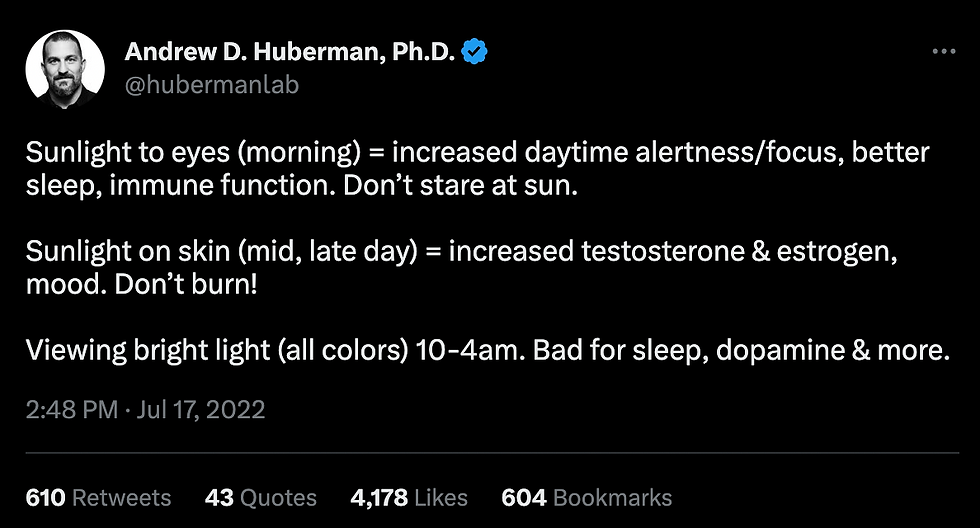
May 26, 2023
In today’s newsletter, I’m going to explain how getting regular sun exposure benefits your mood and energy levels.
This is intuitive to many of us. It's very common to experience lethargy and even depression in dark, gray winters. Once summer rolls around - with longer days and more sunshine - our mood typically lifts.
Unfortunately, many people fear the summer sun and stay inside far too often even on beautiful, sunny days. The pull of our comfortable armchairs and couches, with endless entertainment and work available 24/7 in the form of our smartphones, computers, and TVs, has drastically cut down on the amount of time the average person spends outside.
This is a huge mistake, and many people don't realize the toll this is taking on their mood.
The fact is, regular sunlight exposure is one of the best things you can do for your mental health.
So why is the sun so crucial for mood?
Here are just a few reasons:
Increased vitamin D synthesis
Increased nitric oxide production
Increased levels of sex hormones (estrogen, testosterone)
Increased levels of dopamine and serotonin
In short, getting sun on your skin creates a chain reaction in your body which ultimately leads to better mood, libido, energy, immune function, hormonal health…even pain tolerance!
For many people, getting these benefits is as simple as just getting outside more, but I want to provide some specific guidelines.
Here they are:
Step 1: Build up your tolerance to the sun.
Many people fear the sun, but what they should actually fear is sunburn. Sunburns are a sign that you’ve done damage to the skin, and this is clearly not what we want.
The key is to recognize your skin type. Those who are fair-skinned need less sunlight to make vitamin D and also have less leeway before they’re at risk of burning. Those who are darker-skinned need more sunlight to make vitamin D and can also spend more time in the sun before they start to burn.
Whatever your skin type, you can start to slowly build up a tolerance to bright summer sunshine by incorporating “progressive overload,” similar to how you’d increase weight or reps on your back squat over time.
Start with a very short sun exposure - say, 5 minutes. Do that for a week, then add 3-5 minutes the next week. Build up to whatever your own unique threshold might be before you start to feel like you’re at risk of burning.
Step 2: Make a habit of getting outside for at least 10 minutes around midday (bonus: with as little clothing as possible!).
The goal here is consistent, repeated exposures. Once you’ve increased your sun tolerance, start getting outside daily (or close to daily) around midday, when the sun is directly overhead - that’s when there’s a maximum amount of UVA and UVB rays available (this is what you want to give you all the benefits listed above!).
What you want is to expose as much of your skin as possible, while obviously remaining appropriate for whatever social situation you may find yourself in. You also want to be mindful of the fact that skin that doesn’t often see the sun is at a greater risk of burning, so be cautious.
For those who are very fair-skinned, 10 minutes is likely all you need to get good vitamin D production without risking a sunburn. For those who have darker skin, you may need as much as 30 minutes of midday sun to get the same amount of vitamin D synthesis. The rule of thumb is to stay in the sun for as long as it feels good. Once that comfortable warmth turns to oppressive heat, either go inside, find some shade, or put on more clothes.
Here are some other caveats for how much sun exposure you may need:
If you’re elderly, you may need more sun exposure because your skin likely doesn’t synthesize as much vitamin D.
If you’re obese, you also won’t synthesize as much vitamin D as someone who is lean.
Step 3: Repeat, even on cloudy days!
If you live in a part of the world that doesn’t get a lot of sun, you may be cursing me right now. If you’re not going to allow me to talk you into moving to a sunnier location, at least let me encourage you to make a habit of getting outside, even when the weather is overcast.
Light from the sun is one of the greatest tools we have to modify our hormones and neurotransmitters and thus, our mood and energy. As Andrew Huberman puts it, light sends powerful signals as to what’s going on in the environment around you. Your body takes this signal and triggers a cascade of events that influence your internal biochemistry.
Huberman summarizes the diverse benefits of sunlight here:

And no matter what time of year it is or how much cloud cover there is, there is far more light energy outdoors than inside your house. Even the brightest lights in your home can’t compare with the bountiful light energy that is available outside your door. Take advantage of this wonderful gift!
Try this for the next week or so, and watch for any changes in your mood and energy levels. I would venture to guess that by this time next week, you'll have a spring in your step that wasn't there before.
Helpful resources:
Dminder app to gauge vitamin D levels based on sun exposure
"How to Engineer a Successful Day of Sunbathing" by Mark Sisson
If you enjoyed this newsletter, click the button below. You'll be taken to the email subscriber page to get each edition of HWB in your inbox every Friday.
).png)
Comments